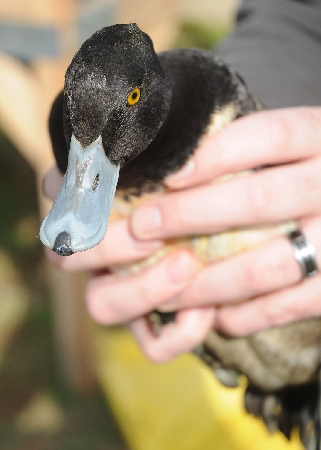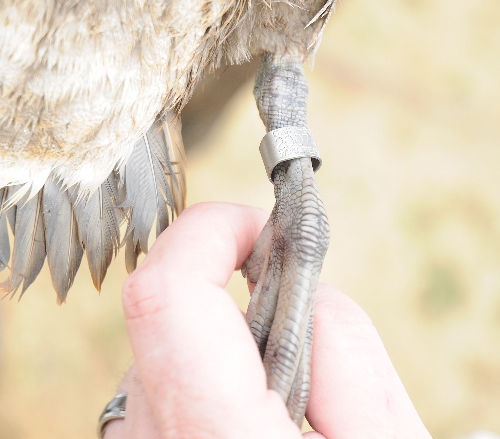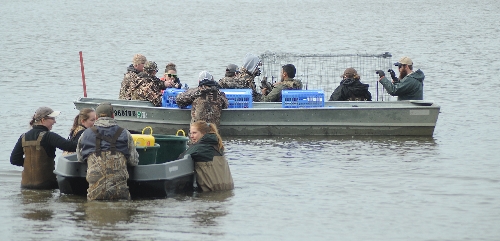University News
WIU Graduate Student Combines Research with Multi-Agency Duck Banding Project
April 6, 2017
MACOMB, IL – The opportunities offered by Western Illinois University's Kibbe Life Science Station in Warsaw, IL, are drawing students and natural resource professionals to the region for a chance to learn more about the migration and health of ducks.
The program is part of a larger effort by the Mississippi Flyway Council and headed by WIU Biology Professor Chris Jacques and WIU Biology graduate student Eric Smith, of Valley City, ND. The banding project also allows Smith and WIU graduate student Andrew Bouton, a biology major from New Haven, VT, the opportunity to conduct research with two focal species, lesser scaup and canvasbacks.
During spring migration, the duck banding team, based at Kibbe Station, is trapping and banding ducks on Pool 19 of the Mississippi River. The team of volunteers deploy specially designed traps to capture birds during migration as the ducks spend time in the area while moving from coastal Louisiana and Cuba to as far north as Canada and Alaska. Smith calls Pool 19 "an important mid-migration stopover site" for both species, where birds can rest and replenish for continued migration and subsequent breeding activities.
Volunteers put on hip waders and walk into the river together, pulling a jon-boat behind with cages for the birds inside. A second boat, with a second set of volunteers, follows behind to replenish the traps with corn.
Smith said the corn is placed under water, so when the ducks dive down to eat they resurface inside the trap. The team removes the birds and places them in the cages to bring to shore to be weighed and banded.
"The data helps to inform us about things like population size, harvest rates and allows us to make survival estimates," said Smith.
The steel bands come from the United States Geological Service (USGS). Smith said this project uses steel-alloy bands because the migration cycle of these ducks includes time in brackish or salt water, which erodes the engraving on aluminum bands.
Sometimes the trapped ducks already have bands and that information is used to track their movement. Other banded ducks could be harvested by hunters, and they, in turn, report the information on the band to help management and conservation efforts.
"Ours is one of only a few scaup banding operations," said Smith. "They can stay [at Pool 19] for a long time. We also collect blood samples, which tells us things like body condition by examining certain metabolites in blood-plasma. For ducks it is important to have large lipid stores for endurance flights during migration and egg production."
The collected birds are weighed, and their sex and species are determined. Once the metal band is attached to their leg, they are released back on the Mississippi River.
Smith said he was drawn to work with the project by retired Louisiana State University (LSU) Professor Al Afton, who previously headed the Mississippi River banding project.
"In 2009, I was invited by Al to get experience with the project," said Smith. "I have volunteered over the years, and when I returned in 2014, we talked about keeping the project going. We wrote a grant and it was funded for five years."
This is the second year of that contract. Because Smith will graduate with his master's degree in biology after the Summer 2017 semester, talks are underway to have the Illinois/Iowa Field Office of the U.S. Fish and Wildlife Service in Rock Island collaborate with Professor Jacques. The banding would still be done at Pool 19.
There are 14 states and three provinces that are part of the Mississippi Flyway Council, and volunteers come from state and federal agencies to help with the banding project. Recently, there were representatives of the Iowa, Minnesota and Michigan departments of natural resources, the U.S. Fish and Wildlife Service and the University of Minnesota. Other volunteers that spend time with the project include workers from the Illinois Department of Natural Resources, Missouri Department of Conservation and Ducks Unlimited.
"A lot of these agencies that help with this donated their employees' time and vehicles," said Smith.
Numerous WIU undergraduate and graduate students and alumni also help with the banding project at various times. Volunteers sleep in the dormitory facilities at Kibbe.
"We owe such a debt of gratitude to Jim Lamer and Sean Jenkins; we couldn't do this project if we didn't have the support of the staff at Kibbe," said Smith.
It was the accessibility of the Mississippi River and the opportunities it offers that Smith said drew him to Western for his graduate school education. After graduation, Smith hopes to do waterfowl and wetlands research for a federal agency or non-profit conservation organization. He is currently working on his thesis, which covers new methods for developing plasma-lipid indices for the lesser scaup species.
For additional information about Kibbe, visit wiu.edu/kibbe.
Posted By: Jodi Pospeschil (JK-Pospeschil@wiu.edu)
Office of University Communications & Marketing




Connect with us: